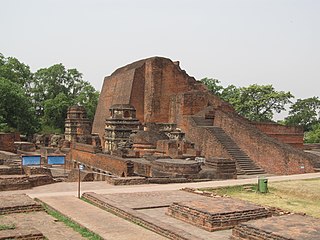
Nalanda was a renowned Buddhist monastic university in ancient Magadha, India. Considered by historians to be the world's very first residential university, and among the greatest centers of learning in the ancient world, it was located near the city of Rajagriha and about 90 kilometres (56 mi) southeast of Pataliputra, operating from 427 to 1197 CE. Nalanda played a vital role in promoting the patronage of arts and academics during the 5th and 6th century AD, a period that has since been described as the "Golden Age of India" by scholars.

Capernaum was a fishing village established during the time of the Hasmoneans, located on the northern shore of the Sea of Galilee. It had a population of about 1500. Archaeological excavations have revealed two ancient synagogues built one over the other. A house turned into a church by the Byzantines is believed to have been the home of Saint Peter.

The Kanheri Caves are a group of caves and rock-cut monuments cut into a massive basalt outcrop in the forests of the Sanjay Gandhi National Park, on the former island of Salsette in the western outskirts of Mumbai, India. They contain Buddhist sculptures and relief carvings, paintings and inscriptions, dating from the 1st century CE to the 10th century CE. Kanheri comes from the Sanskrit Krishnagiri, which means black mountain.
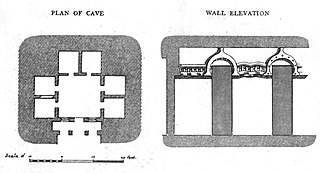
Vihāra generally refers to a Buddhist monastery for Buddhist renunciates, mostly in the Indian subcontinent. The concept is ancient and in early Sanskrit and Pali texts, it meant any arrangement of space or facilities for dwellings. The term evolved into an architectural concept wherein it refers to living quarters for monks with an open shared space or courtyard, particularly in Buddhism. The term is also found in Ajivika, Hindu and Jain monastic literature, usually referring to temporary refuge for wandering monks or nuns during the annual Indian monsoons. In modern Jainism, the monks continue to wander from town to town except during the rainy season (Chaturmas), and the term "vihara" refers to their wanderings.

Vikramashila was one of the three most important Buddhist monasteries in India during the Pala Empire, along with Nalanda and Odantapuri. Its location is now the site of Antichak village, Bhagalpur district in Bihar.

Mahasthangarh is one of the earliest urban archaeological sites so far discovered in Bangladesh. The village Mahasthan in Shibganj upazila of Bogra District contains the remains of an ancient city which was called Pundranagara or Paundravardhanapura in the territory of Pundravardhana. A limestone slab bearing six lines in Prakrit in Brahmi script recording a land grant, discovered in 1931, dates Mahasthangarh to at least the 3rd century BCE. It was an important city under the Maurya Empire. The fortified area was in use until the 8th century CE.

Shravasti was the capital of the ancient Indian kingdom of Kosala and the place where the Buddha lived most after his enlightenment. It is near the Rapti river in the northeastern part of Uttar Pradesh India, close to the Nepalese border.

Somapura Mahavihara in Paharpur, Badalgachhi, Naogaon, Bangladesh is among the best known Buddhist viharas, monasteries, in the Indian Subcontinent and is one of the most important archaeological sites in the country. It is also one of the earliest sites of Bengal, where significant numbers of Hindu statues were found. It was designated as a UNESCO World Heritage Site in 1985. It is one of the most famous examples of architecture in pre-Islamic Bangladesh. It dates from a period to the nearby Halud Vihara and to the Sitakot Vihara in Nawabganj Upazila of Dinajpur District.
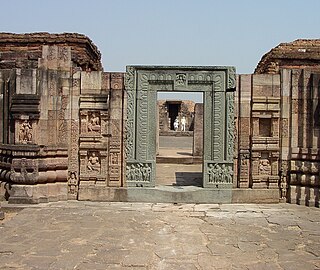
Ratnagiri is the site of a ruined mahavihara, once the major Buddhist monastery in modern Odisha, India. It is located on a hill in between the Brahmani and Birupa rivers in Jajpur district. It is close to other Buddhist sites in the area, including Lalitagiri and Udayagiri, and 100 km (62 mi) from the state capital Bhubaneswar and 70km from the former state capital Cuttack.
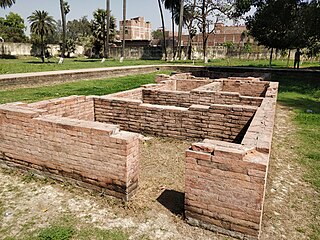
Kumhrar or Kumrahar is the area of Patna where remains of the ancient city of Pataliputra were excavated by the Archaeological Survey of India starting from 1913. It is located 5 km east of Patna Railway Station.
Ekangarsarai is a census town and corresponding community development block in Nalanda district of Bihar state, India.

Jagaddala Mahavihara was a Buddhist monastery and seat of learning in Varendra, a geographical unit in present north Bengal in Bangladesh. It was founded by the later kings of the Pāla dynasty, probably Ramapala, most likely at a site near the present village of Jagdal in Dhamoirhat Upazila in the north-west Bangladesh on the border with India, near Paharapur. Some texts also spell the name Jaggadala.
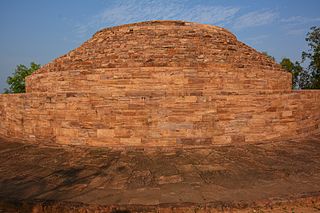
Lalitagiri is a major Buddhist complex in the Indian state of Odisha comprising major stupas, 'esoteric' Buddha images, and monasteries (viharas), one of the oldest sites in the region, Significant finds at this complex include Buddha's relics. Tantric Buddhism was practiced at this site.

Shalban Bihar is an archaeological site in Moinamoti, Comilla, Bangladesh. The ruins are in the middle of the Lalmai hills ridge, and these are of a 7th-century Paharpur-style Buddhist Bihar with 115 cells for monks. It operated through the 12th century.
Silk Road sites in India are sites that were important for trade on the ancient Silk Road. There are 12 such places in India. These are spread across seven states in India (Bihar, Jammu and Kashmir, Maharashtra, Puducherry, Punjab, Tamil Nadu and Uttar Pradesh. These sites are on tentative list of UNESCO World Heritage Sites.
Gabal El Haridi is an archaeological site in Egypt approximately 350 kilometers south of Cairo within Sakulta, in Sohag Governorate in Upper Egypt. The site is located south of Qaw El Kebir (Tjebu), in an area between the towns of El Nawawra and El Gelawiya. The site is very important historically because of the Coptic presence throughout the site. This is because this was the beginning of the use of isolated monasteries that brought the hermits together in a settled community. Significant unknown writings from the Ptolemaic period were found and recorded. The extensive quarrying throughout time suggests that Gabal El Haridi contained one of the more important sources of stone under the Ptolemies and Ramses III. The looting and destruction of the site has caused the site archaeologists great difficulty in determining specific details such as dates and owners of tombs. The details that have been obtained have allowed for a greater understanding of the changes in use of the site throughout its occupation for three thousand years.
Pundranagar in Paundrabhukti was the most important city in the eastern region, now identified with the current site of Mahasthan, located in Bogra, Bangladesh. It was a vibrant administrative, religious and cultural centre from the 3rd century BC to the 12th century AD that is from the Maurya Empire time to the Sena dynasty period. Archaeological remains and literary descriptions speak of a truly planned and magnificent city. City walls, elaborate gates, palaces, common dwellings, assembly halls, temples, viharas, shops, ponds and even suburban temples and viharas characterised the city; Chinese pilgrim, Xuanzang, visiting in the 7th century AD, particularly mentions ponds, orchards, flowers and pleasure gardens.

Sitakot Vihara is an archaeological site located in Nawabganj upazila in Dinajpur district of Bangladesh. The site is locally known as the residence of Sita. Through regular excavations in the years 1968 and 1972–1973, an ancient Buddhist monastery was discovered in the site. The monastery dates from a similar time period to the nearby Somapura Mahavihara and Halud Vihara.

The Archaeological Park of Dion is the most important archaeological site at Mount Olympus in Greece, located in Dion. In the area comprised by the Archaeological Park of Dion, sanctuaries were found from the Hellenistic and Roman periods. The park displays the importance of ancient Dion in the history of Pieria.

Sirpur Group of Monuments are an archaeological and tourism site containing Hindu, Jain and Buddhist monuments from the 5th to 12th centuries in Mahasamund district of the state of Chhattisgarh, India. Located near an eponymous village, it is 78 kilometres (48 mi) east of Raipur, the capital of the state. The site is spread near the banks of the river Mahanadi.






















